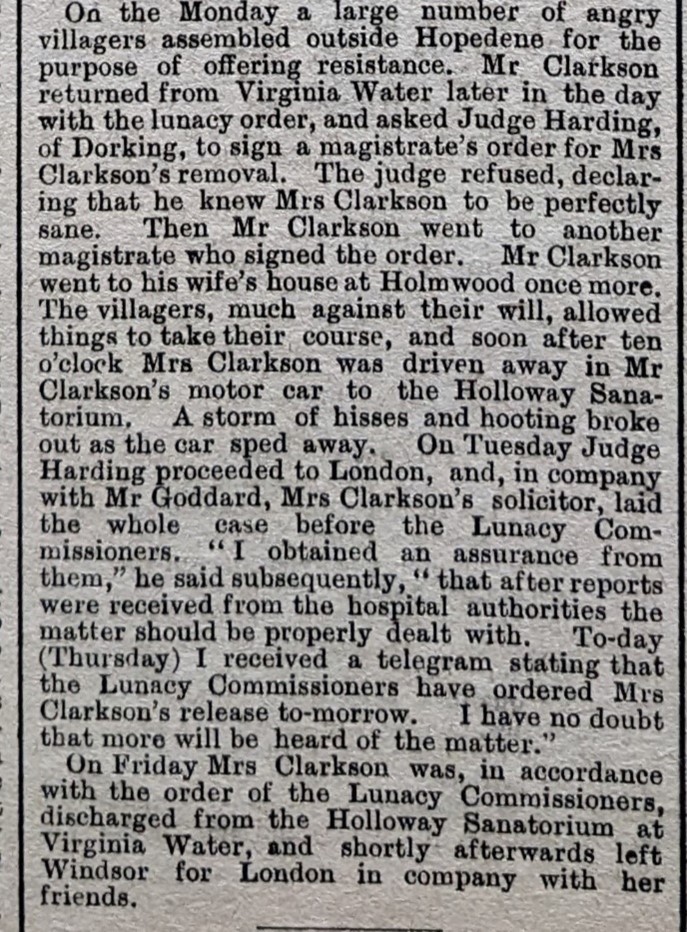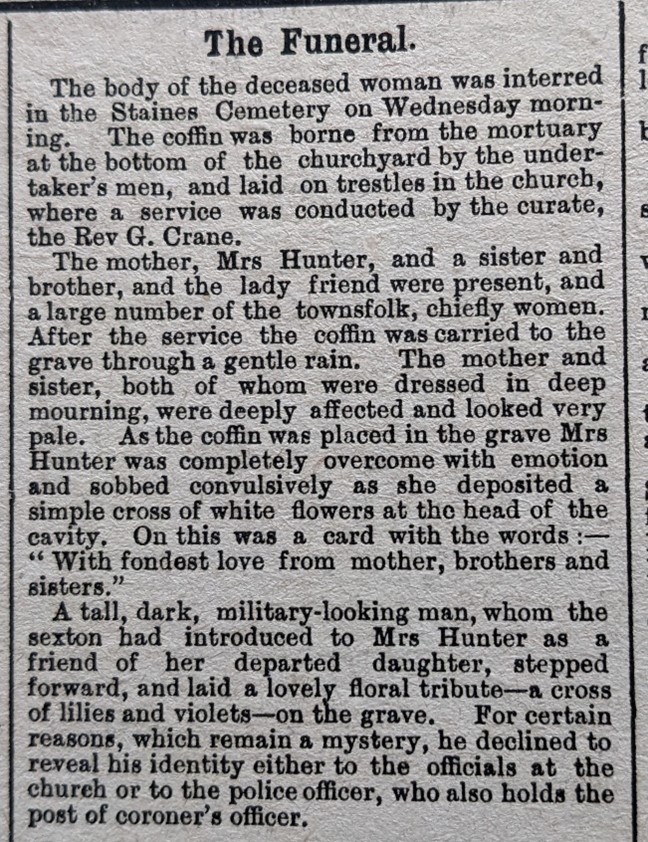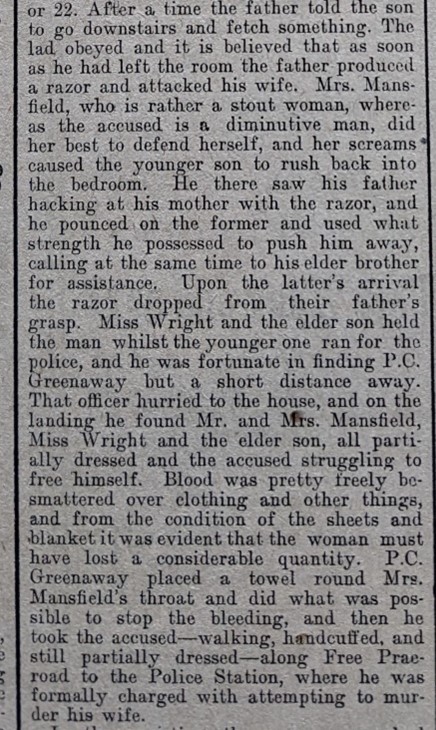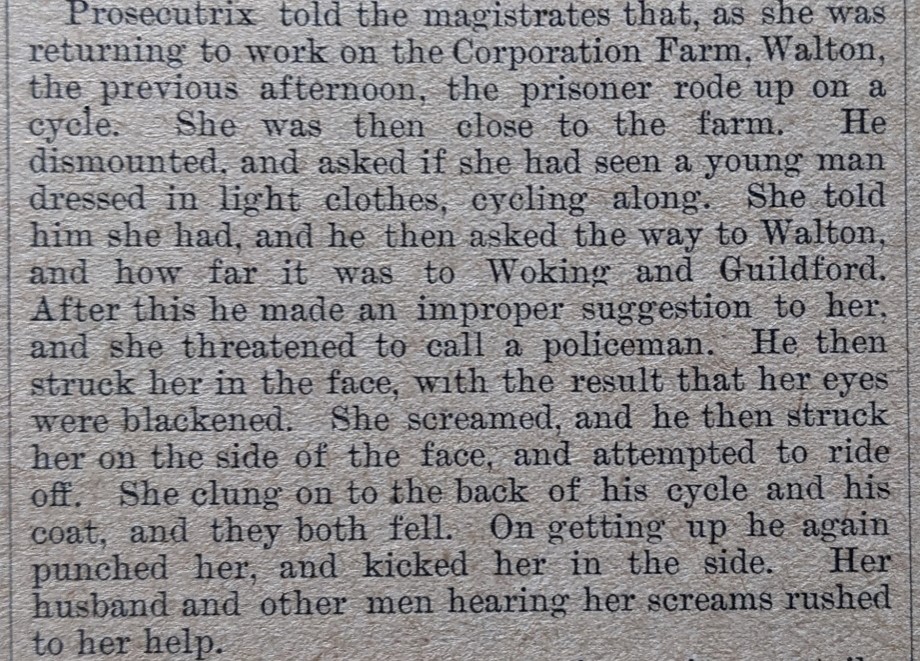Murder, Assault and Abduction: Violence Against Women in the Early 1900s
When I was pouring over Egham Museum’s newspaper collection, looking for traces of Suffragette and Suffragist activity, I was struck by the number of reports of violence against women. It is important to remember the violent climate that some female Suffragettes and Suffragists were living in. Not only were Suffragettes attacked and sexually assaulted by the police during their demonstrations, but women also had to face violence in their homes as well.
Sadly, there were too many articles on violence against women to include here, so I have selected some key articles that demonstrate the horrifying violence that some women experienced. All of these articles are from 1908 and were published in The Surrey Herald.
‘Virginia Water: Lady’s Detention at Holloway Sanatorium’ – The Surrey Herald, 18 April 1908.
In April 1908, a woman had been separated from her husband, but this deed ‘expired on April 4th’. She had told her ‘neighbours her fears that something dreadful might happen after that date’. In the early morning, on 5 April, her husband appeared with two doctors and a signed lunacy order for her. Her husband took her daughter away. He then later appeared with two nurses from Holloway Sanatorium and this woman gave ‘one loud scream of horror’ at their arrival. Remarkably, ‘a large number of angry villagers’ gathered to prevent her from being taken away. However, they failed and there was ‘a storm of hisses’ from the crowd as she was driven away. She was released from Holloway Sanatorium after five days, after her solicitor argued her case to the Lunacy Commissioners.

When I first came across this article I was horrified because this woman was afraid. She knew that her husband wanted to hurt her, and she knew that day was coming. Clearly, their marriage had been abusive for a while and her order of separation had been protecting her from her husband. It is incredible how the people of the village tried to stop her being taken away and made their anger clear. Women were often sent to psychiatric hospitals, like Holloway Sanatorium, as a punishment for breaking the strict social codes of the time – such as having a baby out of wedlock. This woman’s ‘scream of horror’ suggests that she was all too aware of this fact. Her five days at the Sanatorium must have been very traumatic, and the article does not mention what happened to her daughter. Violence against women does not have to be physical. The mental torture that some women endure is equally as horrifying.
Photo Credit: The Surrey Herald, 18 April 1908.
‘Double Tragedy at Staines: Woman Shot Dead at Piano’ – The Surrey Herald, 25 April 1908.
In April 1908, a ‘housemaid’ in Staines ‘made the shocking discovery of her mistress’s dead body’ who had been shot in the head whilst playing the piano. The newspaper noted that the murdered woman and a man, married ‘lovers’ who were having an affair, had an argument recently that caused this woman to leave Staines. However, the man ‘spent some days looking for her’ and she returned. The man killed this woman, and then killed himself. He left behind notes that read “beautiful woman”, “I loved her too much”, “don’t lie” and “never trust any woman”. The case at the inquest was described as ‘very unsavoury’, not because of the murder, but because of the ‘disgusting’ affair. The murdered woman’s mother had been living with the pair because her ‘daughter said she was so lonely’ and she ‘kept on asking [her mother] to stay’. At the inquest, her mother noted that the man ‘was jealous of everyone’.

At the inquest into the murder, the murdered woman was almost put on trial for having an affair. Her mother was called as a witness and had to defend her dead daughter which must have been a horrifying experience. What struck me most was the suicide notes the murderer left, which included the words “never trust any woman”. How many women have been killed because of men’s rage and jealousy? How many women have been blamed for their attackers’ actions? I was also touched by the funeral held for this woman. Her mother, sister and brother attended, flanked by the people of Staines who were ‘chiefly women’. Evidently, the women of Staines were as affected by this violence as I was, reading about it over 100 years later.
Photo Credit: The Surrey Herald, 25 April 1908.
‘Alleged Attempted Murder in Chertsey’ – The Surrey Herald, 19 September 1908.

In September 1908, a husband in bed with his wife drew a razor and attacked her. Their 13-year-old son heard her screaming and ‘he there saw his father hacking at his mother with a razor’. The boy jumped on his father, and with the help of his older brother, managed to stop their father’s attack. This man was arrested for attempted murder. The newspaper reported that ‘blood was pretty freely be-smattered over clothing and other things’.
Domestic violence has existed throughout history, and this is one such case. It was difficult to read about how the 13-year-old boy rushed to save his mother, but also had to witness that violence first hand. This article echoes the fact that today, in the UK, 62% of women that are killed are murdered by ‘a current or former partner.’
Photo Credit: The Surrey Herald, 19 September 1908.
‘Walton Woman Assaulted’ – The Surrey Herald, 5 December 1908.

In December 1908, a man made an ‘improper suggestion’ to a woman in Walton, who then ‘threatened to call a policeman’. This man then punched her, giving her black eyes, and also, after a struggle, kicked her. The newspaper described this as ‘a very unprovoked assault’ and the attacker was sentence to one month’s hard labour.
This article showed how a woman walking alone in 1908 experienced the same violence and harassment that some women face today. She rejected a man’s advances and was beaten for it. This is an all too familiar story.
Photo Credit: The Surrey Herald, 5 December 1908.
These newspaper articles, from one newspaper over the course of one year, show that violence against women has always been present and can take many forms, from assault, to coercion, to abduction and murder. We need to remember that the Suffragists and Suffragettes had lives outside of their campaigning and may have lived in a violent home or have been trapped in an abusive marriage. Women fighting for the right to vote wanted the ability to shape laws that would protect them and make them safer. Many Suffragettes, such as Kitty Marion, were radicalised after being abused or assaulted by men.
A National Union of Women’s Suffrage Societies’ pamphlet from July 1913 stated that, ‘as long as women cannot vote for Members of Parliament they are not asked what they want, and they are treated like children who do not know what is good or what is bad for them… only those who wear the shoe know where it pinches, and women know best what they want and what they don’t want.”
The right to vote was more than the ability to tick a box on polling day. The right to vote would give them more control over the laws which determined their safety. The right to vote would mean they were no longer second-class citizens. The right to vote could save some women’s lives.
Now we’ve uncovered the climate that these women were living in, who exactly were the Suffragettes and Suffragists?
Travel back to 1913 by playing the free online puzzle game ‘The Mystery of the Missing Suffragette’ to learn more about Suffragettes and Suffragists. Visit Royal Holloway and Egham, attend The Egham and District Women’s Suffrage Society meeting, and use your puzzle-solving skills to uncover the truth about “Mary Dean”. This game is suitable for ages 14 and over.
Further Reading:
Maggie O’Farrell, The Vanishing Act of Esme Lennox (2006).
Jina Moon, Domestic Violence in Victorian and Edwardian Fiction (2016).
The Facts, Refuge, https://refuge.org.uk/what-is-domestic-abuse/the-facts/
Information and support if you have been affected by the issues mentioned in this article:
Getting help for Domestic Violence, NHS, https://www.nhs.uk/live-well/getting-help-for-domestic-violence/
Help after rape and sexual assault, NHS, https://www.nhs.uk/live-well/sexual-health/help-after-rape-and-sexual-assault/

I do not even know how I ended up here, but I thought this post was great. I don’t know who you are but definitely you’re going to a famous blogger if you aren’t already 😉 Cheers!